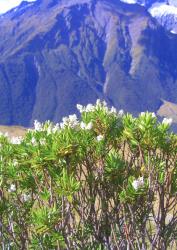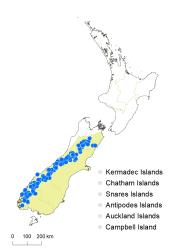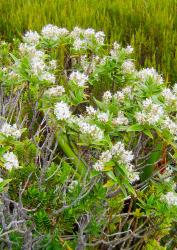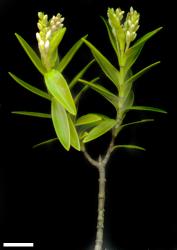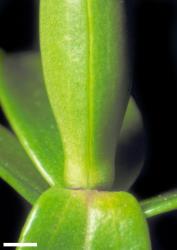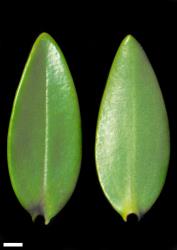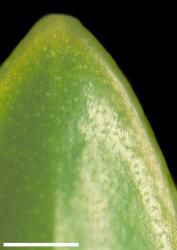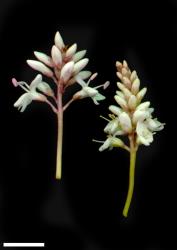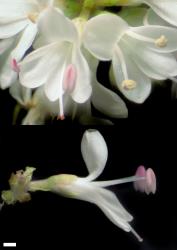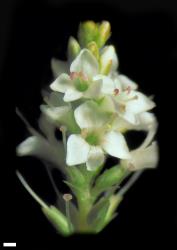- ≡ Hebe subalpina (Cockayne) Andersen, Trans. New Zealand Inst. 56: 693 (1926)
- = Veronica montana J.B.Armstr., N.Z. Ctry. J. 3: 58 (1879) nom. illeg., non Veronica montana L. 1755
- ≡ Veronica monticola J.B.Armstr., Trans. New Zealand Inst. 13: 354 (1881) nom. illeg., non Veronica monticola Trautv. 1866
- ≡ Hebe monticola Andersen, Trans. New Zealand Inst. 56: 693 (1926) nom. nov. pro Veronica montana J.B.Armstr. 1879
- ≡ Hebe montana (J.B.Armstr.) Cockayne & Allan, Trans. New Zealand Inst. 57: 31 (1926) nom. illeg.
- ≡ Hebe monticola A.Wall, Trans. & Proc. New Zealand Inst. 60: 385 (1929) nom. illeg., non Hebe monticola Andersen 1926
- = Hebe fruticeti G.Simpson & J.S.Thomson, Trans. Roy. Soc. New Zealand 70: 30 (1940)
Bushy or spreading low shrub to 1.4 m tall. Stems decumbent to erect, eglandular-pubescent, glabrous with age; hairs bifarious. Leaf bud distinct, its leaves appressed at margins until fully grown; sinus absent. Leaves opposite-decussate, erecto-patent to spreading; lamina sub-coriaceous to coriaceous, lanceolate to elliptic to oblong-elliptic, rarely linear-lanceolate, 7–51 mm long, 3–11 mm wide, glossy, pale to dark green above, pale green beneath; midrib evident; surfaces glabrous or with eglandular hairs along midrib above; margin glabrous, narrowly cartilaginous, entire; apex sub-acute to obtuse, not or very weakly plicate-acuminate; base cuneate to abruptly cuneate; petiole absent or indistinct, 0–2 mm long. Inflorescence a lateral raceme, 11–60 mm long; flowers crowded, 4–32, female or bisexual on separate plants, ⚥ > ♀; bracts alternate, lanceolate to ovate, ≤ pedicels; pedicels erecto-patent, 0.8–5.5 mm long, pubescent or puberulent, occasionally a few hairs glandular. Calyx lobes 4, sub-acute to acute, 1.6–2.3 mm long, sub-equal, mixed glandular- and eglandular-ciliolate. Corolla 5–10 mm diameter; tube white, 1.0–2.2 mm long, ≥ calyx, eglandular-hairy inside; lobes 4, white, rarely pale pink, erecto-patent to spreading, unequal, lanceolate to broadly ovate or elliptic, oblong, or deltoid, 2.5–5.0 mm long, sub-acute to obtuse; nectar guides absent. Stamen filaments white, 3–6 mm long; anthers pink to magenta. Style glabrous, 4–10 mm long. Capsules latiseptate, sub-acute to obtuse, glabrous, 3–5 mm long, 2.4–3.0 mm at widest point (rarely up to 6.5 mm long, 3.5 mm wide). Seeds ellipsoid, sometimes broadly, flattened, smooth, pale brown, 1.2–2.0 mm long.
V. subalpina is most likely to be confused with V. rakaiensis, V. treadwellii, and V. urvilleana.
V. rakaiensis plants may be distinguished by their broader, more obovate leaves, with minutely plicate-apiculate apices and minute hairs on the margins, some of the calyx lobes rounded at the apex, the corolla lobes rounded and usually sparsely to moderately ciliate or ciliolate, and the ovary and often the base of the style hairy.
V. treadwellii plants may be distinguished by their low-spreading habit, broader, dished, obovate to oblanceolate or elliptic leaves, and often longer corolla tubes (1.9–3.5 mm long).
V. urvilleana plants are very similar and differ in quantitative characters that overlap in values. Their leaves and flowers are mostly smaller, and they have fewer ovules per ovary. They also differ in chromosome number.
V. calcicola plants have hairy ovaries and capsules, hairy leaf margins, and short, rounded corolla lobes. All plants of V. calcicola apparently have combined sexes.
Plants of V. truncatula, known only from the Ruahine Range, North Island, are similar to V. subalpina, but have a few consistent differences. Their leaf margins are minutely ciliolate and thus similar in this feature to V. rakaiensis. In addition, they have more flowers (28–68) per inflorescence, which may be loosely whorled, and sometimes there is a tail of undeveloped flower buds at the tip of the inflorescence, all features seen in V. stricta and similar species. Also, the flower shape is reminiscent of V. stricta. V. truncatula plants also have rather narrower leaves than is usual in V. subalpina, although there is overlap in the ranges, and V. truncatula leaves have few or no evident stomata on the upper surface (V. subalpina leaves tend to have abundant stomata). The leaf of V. truncatula has a distinctive apex, in which the broad plicate-acuminate tip is minutely truncate and somewhat hollowed on the adaxial surface.
South Island: Westland (from Nelson Lakes National Park southwards) and western parts of Marlborough, Canterbury, Otago, and Southland.
Sub-alpine shrubland, penalpine grassland, occasionally in beech forest near the tree line and along stream banks. Recorded elevations range from 300 m (there is one record at 182 m) to 1525 m.
Flowers: November–February; fruits: December–May, persisting longer.
2n = 80 (see Bayly & Kellow 2006, as Hebe subalpina).
Veronica subalpina is classified in V. subg. Pseudoveronica sect. Hebe and the informal group “Occlusae” (Albach & Meudt 2010; Bayly & Kellow 2006). V. subalpina might be sister species to V. treadwellii; this is supported by their close similarity and analysis of ITS sequence data.



